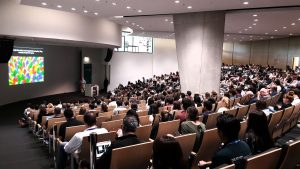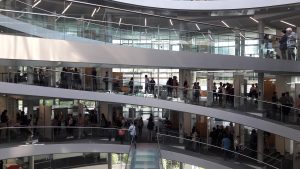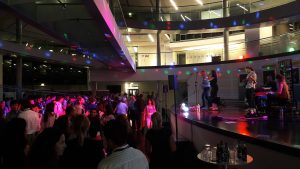Organoids: Modelling Organ Development and Disease in 3D Culture
EMBO | EMBL Symposium – Heidelberg, 10-13 September 2018
Meeting report by Veronica Foletto
Following the huge success of the 2016 symposium ‘Organoids: Modelling Organ Development and Disease in 3D Culture’, Hans Clevers, Jürgen Knoblich, Melissa Little, and Esther Schnapp joined forces to organise a second such symposium this year. On the afternoon of 10 September, 460 scientists from all over the world gathered in the auditorium of the EMBL Advanced Training Centre (ATC) in Heidelberg.

Hans Clevers, a leading expert on organoids, welcomed everyone and led the opening session. The first keynote lecture was given by Jürgen Knoblich, who reported on progress in his lab using cerebral organoids to model the complexity of the human brain and, in particular, to study microcephaly. The subsequent talks showed how organoids derived from different tissues provide useful models for the recapitulation of certain diseases – such as Helicobacter pylori infection and secretion of the VacA toxin in the stomach, as discussed by Xuebiao Yao – or models of early development, with Nicolas Rivron introducing the blastoid: a type of organoid similar to an early embryo, which can be used to study developmental processes in 3D.
The second day began early with an interesting ‘Meet the Editors’ session, in which scientists had the chance to talk directly to editors working for many scientific publishers (Springer, Nature, The Company of Biologists, Wiley, Cell Press and EMBO press) and to understand their vision.
Afterwards, Meritxell Huch chaired the session ‘Stem Cells and Development’, in which scientists presented advancements in the use of cerebral (Wieland Huttner) and pancreatic (Anne Grapin-Botton) organoids for deciphering cellular mechanisms during human development, and of gastruloids for studying the patterning of the antero-posterior axis (Denis Duboule). Near the end of the session, Bon-Kyoung Koo described how to efficiently use CRISPR technology to perform genetic studies in intestinal organoids. The session ended with a series of 2-minute flash talks, after which networking and interactions were encouraged during lunch, where there was an opportunity to meet the day’s speakers.
The beautiful helices of the ATC then provided the venue for the first poster session, where around 90 presenters had the chance to discuss their research with fellow scientists, editors, and a scientific evaluating committee. It was absolutely inspiring to see how many people work on organoid research!

The afternoon session, ‘Organoids from tissue stem cells’, included talks on organoids derived from taste stem cells (Peihua Jiang), cochlear cells (Albert Edge), and intestinal cells (Hans Clevers). Madeline Lancaster explored the possibility of studying differentiated human cerebral organoids which self-assemble in the stereotypic organisation of the early human embryonic brain and have functional motor-neuronal circuits.
Among this ‘zoo of organoids’ – as humorously defined by Jürgen Knoblich – there was room for organoids derived from snake venom glands (Yorick Post): the organoid toolbox seems to be extendable to non-mammalian cultures as well!
On Wednesday morning, James Wells introduced the session ‘Recreating organs from pluripotent stem cells’. This addressed cell fate decisions in the developing mouse thyroid gland or lung (Sabine Costagliola), the human lung (Jason Spence and Hans-Willem Snoeck), the human salivary gland (Cecilia Rocchi), and the human forebrain (Flora Vaccarino), studied primarily through single-cell transcriptome and enhancer analyses. Finally, it was the turn of Mathew Garnett, who started by showing that the worldwide number of new cases of cancer each year is around twice the population of Switzerland.
Interested in using precision organoid models to study cancer and patients’ responses to treatment, Garnett is now contributing to the development of the Human Cancer Models Initiative. Its goal is to create a new generation of molecularly annotated cancer models, which will be widely beneficial to the scientific community.
After the second poster session, there were talks on ‘Organoids and disease modelling’, introduced by Anne Grapin-Botton. Among the topics covered were the use of 3D organoids to model liver regeneration and disease (Meritxell Huch), and to study cancers of the bladder (Michael Shen), pancreas (David Tuveson), breast (Martin Jechlinger), and colon (Henner Farin).
The day ended beautifully with the conference dinner in the EMBL canteen and the delightful live music that brought together the diverse group of researchers once again.

The final day of the conference was dedicated to ‘Cells and materials in regenerative medicine’. Matthias Lutolf discussed some of the ongoing efforts in his research group to develop next-generation organoids through tissue engineering. Meritxell Cutrona reported advances in nanoparticle tracking in 3D structures, which is particularly useful for drug delivery. Lakmali Atapattu described 3D bioprinting of tumoroids. Henrik Renner presented a high throughput-compatible workflow for the generation, culture, and optical analysis of neural human organoids. Rob Coppes and Melissa Little reported on promising progress in improving cancer treatment, using glandular and kidney organoids, respectively. James Wells gave a talk on the applications of gastrointestinal organoids, concluding with some food for thought for the audience: “It is better to collaborate, than to compete.”
The Symposium ended with the poster prizes, sponsored by EMBO Reports, EMBO Molecular Medicine, and Sartorius. Personally, I found these four days extremely stimulating, full of opportunities for interaction and discussion. I believe most of my fellow researchers got the same feeling: 3D organoid systems are revolutionising molecular biology and driving the development of better clinical therapies, and we are all contributing to this revolution.
What will we be able to achieve with organoids in two years’ time?
Stay tuned, the meeting will be back in 2020!
@LunardiLabCIBIO